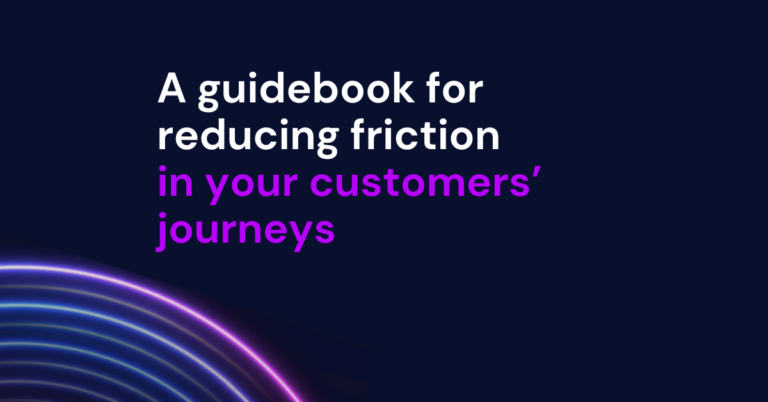Podcast
How to reduce friction in the customer journey
Customer friction is one of the most underestimated barriers to business growth. It’s an invisible force that quietly derails your customers’ experience, preventing your organisation from reaching its full potential.
In my latest podcast episode, “How to reduce friction in the customer journey,” I am joined by b2b marketing operations experts Context Marketing Consultancy to unpack this critical challenge and share actionable strategies for B2B leaders. Watch the full episode below for the complete discussion, or keep reading for highlights and key insights. For more in-depth strategies, download the accompanying e-book.
Reducing friction in your customers’ journeys really matters
In today’s competitive market, a smooth customer journey isn’t just a “nice-to-have”—it’s a business necessity. When discussing friction in the customer experience or journey, we often focus solely on the customers’ direct interactions with our business. However, we tend to overlook internal friction points—such as silos, inefficient processes, and outdated technologies—that indirectly but significantly impact customer experiences. These issues frequently go unnoticed until they begin to affect your bottom line.
The key to reducing friction lies in uncovering and addressing its root causes. This starts by listening to all your audiences—customers, employees, and stakeholders. Through structured, meaningful conversations, you can identify hidden challenges, resolve them systematically, and create a seamless experience. This approach not only enhances satisfaction but also drives growth, reduces risks, and streamlines processes, delivering value across your organisation. And the best part? Many of these insights come from conversations with people who already know what needs to be fixed.
Core principles for building friction-free customer journeys
1. Internal alignment is the foundation of a great customer experience
Internal silos, misaligned goals, and inefficient processes are often the root causes of customer friction. By engaging with your teams and listening to your customers, you can align internal objectives with customer needs, ensuring a seamless and satisfying experience for all.
2. Data combined with qualitative insights drives meaningful action
While quantitative data reveals where friction occurs, qualitative insights explain why it happens. Together, they provide a holistic understanding of issues and inform targeted solutions.
3. Employees know where to uncover hidden opportunities
Your employees are often your most valuable source of insight. Those who interact with customers daily—whether in sales, support, or operations—have a deep understanding of common pain points and untapped opportunities. By creating forums for employees to share their observations and ideas, you not only uncover actionable insights but also foster a sense of ownership and engagement across teams. Empowered employees feel heard and motivated, contributing directly to improving the customer journey and driving business growth.
4. Leverage voice of the customer programmes for actionable insights
Voice of the Customer (VoC) programmes are structured feedback systems that gather high-quality insights from customers, providing invaluable perspectives that drive better decision-making. VoC initiatives help you understand customer needs, pain points, and expectations directly from the source.
When structured effectively, these programmes create a continuous feedback loop that informs every aspect of your customer experience and your strategy.
Actionable takeaways for B2B leaders
Here are three practical steps you can implement immediately:
- Conduct qualitative research with all your audiences: Engage with employees, customers, and stakeholders to uncover hidden challenges and opportunities. Listening fosters a culture of trust and provides actionable insights.
- Create Cross-Departmental Working Groups: Bring together representatives from marketing, sales, customer service, and IT to collaborate on reducing silos and improving customer experience from within.
- Invest in future-proofing your team’s capabilities: Identify current skills gaps and potential future needs, then create a structured plan to address them. Regular training and open communication empower your teams to deliver exceptional customer experiences.
Conclusion: Reducing friction in your customer journeys delivers lasting impact
Addressing customer friction goes beyond improving experiences—it transforms your business. By prioritising alignment, fostering collaboration, and leveraging data and insights, you create a resilient organisation that can adapt and grow sustainably. The benefits include improved retention, reduced risks, and increased conversion rates, all driven by a culture of continuous customer understanding.
Ready to take action?
Reducing friction in your customer journey starts with understanding the root causes. By engaging employees, customers, and stakeholders, you can identify and resolve hidden barriers.
If you’re ready to equip yourself and your leadership team with the high-quality insights needed to make confident, strategic decisions, I’m here to help. Together, we can uncover valuable perspectives that empower you to develop data-driven strategies, align your business goals with customer needs, and deliver measurable results. Let’s connect—send me a message or find me on LinkedIn.
I also highly recommend connecting with Vicki and Colette from Context Marketing Consultancy. Their expertise in marketing operations and strategy complements the friction-reduction insights we’ve discussed, helping businesses streamline processes, optimise technology, and align teams for maximum impact. With their tailored approach and deep industry knowledge, they’ll guide you toward delivering seamless customer experiences that drive growth and build long-term success.
For further strategies and actionable advice, watch the full podcast episode above or download the comprehensive e-book, an essential guide for leadership teams to identify and eliminate the barriers that frustrate customers and hinder success.



